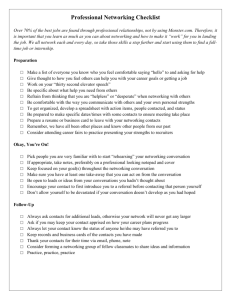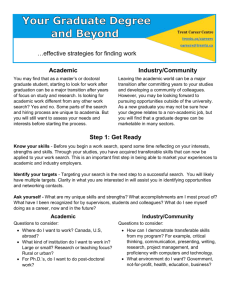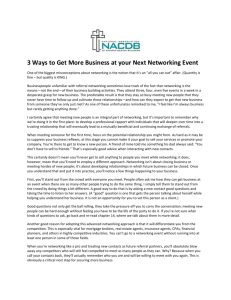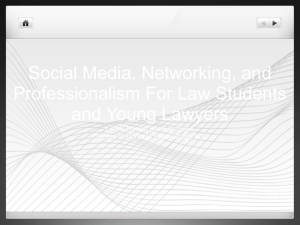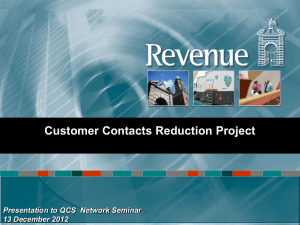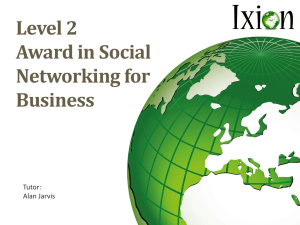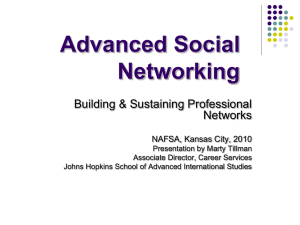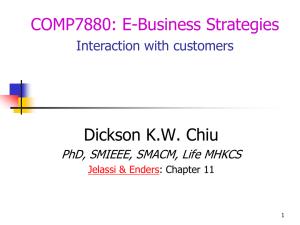Effective Networking
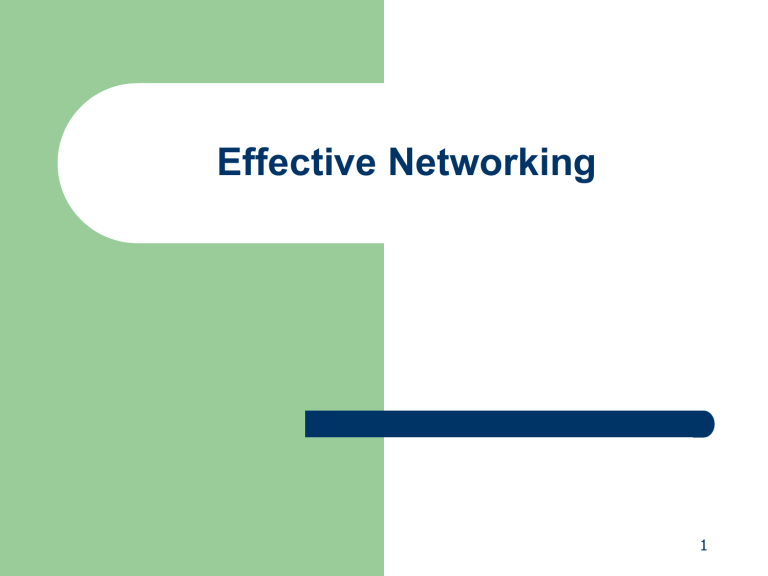
Effective Networking
1
Agenda - -
What is Networking?
Introversion vs. Shyness
Getting Started Do’s and Don’t’s
How to Network
F.O.R.M. format for Networking
Networking at events
Types of questions
Recommended reading
2
What is Networking?
Forming relationships for the purpose of gathering and sharing:
– Information
– Ideas
– Support
3
What is Networking?
Networking is not . . .
– Asking for a job
Networking is . . .
– Asking for a small favor
– Asking for some information
– Asking for advice
– A strategy for managing you career!
4
Introversion vs. Shyness
Introversion
– Not the same as shyness
– Way of engaging the world, being involved
Shyness
– Way of disengaging from the world, being uninvolved
– There are shy extroverts
5
Introverts
Characteristics and Strengths
Concentration, focus
Skilled in listening and observing
Often form deeper, longer-lasting relationships
Behavior is generally seen as consistent
Reliable, dependable, thoughtful, sympathetic
6
Extroverts
Characteristics and Strengths
Enjoy human interactions, enthusiastic
Talkative, assertive, gregarious
Enjoy time spent with people
Take pleasure in large social gatherings
(e.g., parties, community activities, public demonstrations, and business or political groups)
7
Where Do I Start?
3.
4.
1.
2.
5.
6.
7.
Identify your needs
Determine your target network contacts
Distinguish what you have to offer a network
Draw a physical “map” of your potential network
Develop a plan to contact these people to build rapport
Set up a simple tracking system for contacts
Implement the plan
8
Getting Started Do’s
Do
–
–
–
–
–
–
–
–
Email your contacts a magazine article of interest
Tell them about a meeting or speaker that they might enjoy
Offer to help with a crunch they may be facing
Pass along a compliment you heard about them
Say something complementary about them to others
Help one of their family members
Invite them to do something outside of work that is appropriate (i.e., golf, tennis, dinner with guest, etc.)
Always present a professional image
9
Getting Started Don’t’s
Don’t
–
–
–
Add your target network contacts to your e-mail joke distribution list
Contact them constantly
Give them expensive gifts
– Call or e-mail just to chat: have a clear purpose, then you can chat if desired
10
How to Network
1.
Develop a contact list
“A” Contacts
–
–
Already known
Instant rapport
– Can provide feedback on your presentation
– Referrals to “B” contacts
“B” Contacts
–
–
Bridge people
Information resources on: activities, people and events in the field
–
–
Needs and problems in fields
Referrals to other “B” and “C” contacts
“C” Contacts
– Can make hiring decisions
–
–
–
Receive proposals
Create jobs
Refer to other “C” contacts 11
How to Network
(continued)
2.
Setting up an Informational Meeting
Greeting and reference to referral
– Hello (contact’s name). (Referral’s name) recommended that I contact you. My name is (first and last name).
Purpose
– I am currently researching (industry, function, etc.) and
(Referral’s name) thought that you would be an excellent resource for me to find out (information you are seeking). The reason I am interested in this information is . . . .
Reassurance – I want to emphasize that I am gathering information at this time in my job search. I clearly do not expect you to know about any opportunities. My intent is to benefit from your knowledge and experience in (industry, function, etc.).
12
How to Network
(continued)
2.
Setting up an Informational Meeting (continued)
Ask for meeting
– Would you be available to meet with me to discuss these issues for 30 minutes sometime next week? Would (date / time) be convenient, or is there a better time for you?
Confirm meeting location
– I will be there with you at (date / time) (in your office) at (location) that day.
Thank you
– Thank you for your time. I am looking forward to talking with you.
13
How to Network
(continued)
3.
Conducting the Information / Referral Meeting
Build rapport
– Warm up conversation emphasizing connection with the referral source
Self presentation
– Objective of the meeting, background summary, options currently exploring
Focusing in
– Questions proceed from general to specific (industry / sector business issues, common problems and critical issues, solutions tried, and specific need)
14
How to Network
(continued)
3.
Conducting the Information / Referral Meeting (continued)
Ask for referrals
– Who else should I be talking to?
Thank you – Show appreciation and ask for business card for correct spelling of name and title for thank you letter
Next steps – Mention any follow up
15
F.O.R.M. Format for Networking
Family
Recreation
Occupation
Me
16
Correspondence and Recordkeeping
–
–
–
–
–
–
Promptly send a Thank You letter or e-mail to your contact thanking them for their time and interest in your job search. Recap your strengths and career focus, and remind them of any next steps they agreed to.
Early on, develop a tracking system as your contacts will grow quickly.
This can be done in Outlook, or on a simple spreadsheet. Things to include are:
Purpose of meeting, including date and time of meeting
What did you learn about the person you met (background interests, etc.)?
Did you learn anything that confirmed or modified your career objective?
Problems and needs of the company or industry
Referral’s name, function and background
Next steps
17
Networking at events; pre-arrival
Who will be attending?
Agree to separate if going with others
Determine how long the event is going to last and set your strategy
Set a goal - - meet 3 or more people
Bring business cards
Turn off phone or set to vibrate
18
Networking at events; arrival
Ask to see / look at attendance list
Put your name tag on right hand side
Write your name BIG and legibly if not pre-printed
Arrive exactly on time or early
Smile, direct eye contact and be upbeat
Give a firm handshake
Don’t drink or eat too much
Easiest to meet people near the bar or food
Look for another person who is standing alone
19
Conversation Starters
Hello, how are you?
I’m so and so
So are you a member here?
Have you been to this type of (event, meeting, etc.) before?
Do you have a particular interest in today’s (topic, speaker, etc.)?
What do you do?
Do you know many people here?
20
How to Exit a Conversation
Pay attention to the person with whom you are speaking
Don’t say you have to use the restroom unless you really do
Say things like:
– It was great speaking with you and I am so glad we met
– I enjoyed speaking with you; I am going to go refresh my drink
Exchange business cards if you want to follow up
Follow up promptly (within 1-2 days)
21
Types of Questions
Closed
–
–
–
–
What / Who
Yes / No answers
Factual
Appeal to analytical side of the brain
Open-ended
–
–
–
How / Why, Tell me about . . .
Can’t answer with 1 or 2 words
Appeal to the imagination
22
Keep this in Mind
When networking . . .
– Others may be nervous too
– Leverage introverted strengths
– Be yourself and try to have fun
– Develop a greater tolerance for discomfort
23
Recommended Reading
Little Black Book of Connections
Jeffrey Gitomer
Make Your Contacts Count
Anne Baber and Lynne Waymon
24
